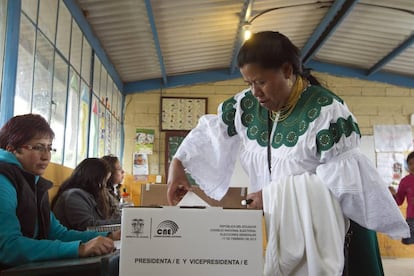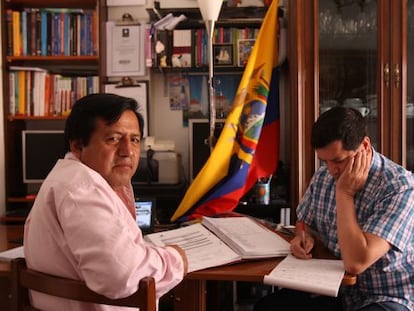Why Ecuador may be voting with smiley faces in 2017 election
Ballot papers with drawings instead of crosses are allowed, as long as they express positive feelings
A smiley face, a red kiss or a heart. Any symbol that clearly expresses one’s voting intention on the ballot paper will be as acceptable as a cross in the presidential elections coming up in Ecuador on February 19. It will be up to the officers manning the polling stations to interpret citizens’ voting intention when the latter is expressed through a drawing.

The National Electoral Council is now training the individuals who will sit at the stations, to ensure that those votes get counted – unless they are unclear.
“If you have a box to check in order to choose the presidential nominee or any other candidate, you can place the vertical line over the horizontal one, but if you draw a happy face as an expression of acceptance, it is also considered valid,” explains Tania Arias, in charge of officer training at the Electoral Delegation in Guayas province.
This possibility is implicit in the Democracy Code that regulates elections in Ecuador. The code says that authorities will consider valid any “votes cast on ballot papers supplied by the Council and which intelligibly express the voter’s will in any way.” No further details are provided.
It takes away from the seriousness of the process, and creates unnecessary uncertainty at such an important moment of change
César Montúfar, Movimiento Concertación
EL PAÍS asked the vice-president of the National Electoral Council, Nubia Villacís, about the decision to accept drawings as votes, and whether it is not arbitrary to leave interpretation at the discretion of polling station officers. This official did not answer any of the queries.
But these and other questions regarding the interpretation of electoral rules are a source of concern for political parties running in the 2017 elections.
Leaders of Compromiso Ecuador, which supports the main opposition candidate Guillermo Lasso, of Movimiento Creando Oportunidades, believe that any symbol that is not a vertical line (superimposed on the pre-existing horizontal line to create a cross) “is open to arbitrariness and subjectivity,” said Francisco Jiménez.
Wilma Andrade, national president of Democratic Left —whose nominee is former Quito mayor Paco Moncayo— wondered what will happen if somebody draws a sad face against the name of one of the presidential nominees.

“They could interpret it as dislike for the candidate...that is subjective and it would be very dangerous,” she said.
César Montúfar, head of Movimiento Concertación, which is allied with Social Christian Party candidate Cynthia Viteri, thinks that this kind of issue is part of a distraction strategy.
“It takes away from the seriousness of the process, and creates unnecessary uncertainty at such an important moment of change,” he said.
With three weeks to go before the presidential campaign to elect a substitute for President Rafael Correa officially kicks off, the National Electoral Council has yet to issue specific guidelines as to how each symbol should be interpreted.
The official in Guayas province said that if the drawing expressed a positive feeling, the ballot would be considered valid, but if it expressed a negative one, it would be declared spoiled.
Council president Juan Pablo Pozo has sought to allay fears by stating that the number of “smiley face” votes is minimal and that a vast majority of voters express their will clearly.
In 2015, UK-based newspaper The Guardian reported on the existence of similar guidelines in Britain.
English version by Susana Urra.
Tu suscripción se está usando en otro dispositivo
¿Quieres añadir otro usuario a tu suscripción?
Si continúas leyendo en este dispositivo, no se podrá leer en el otro.
FlechaTu suscripción se está usando en otro dispositivo y solo puedes acceder a EL PAÍS desde un dispositivo a la vez.
Si quieres compartir tu cuenta, cambia tu suscripción a la modalidad Premium, así podrás añadir otro usuario. Cada uno accederá con su propia cuenta de email, lo que os permitirá personalizar vuestra experiencia en EL PAÍS.
¿Tienes una suscripción de empresa? Accede aquí para contratar más cuentas.
En el caso de no saber quién está usando tu cuenta, te recomendamos cambiar tu contraseña aquí.
Si decides continuar compartiendo tu cuenta, este mensaje se mostrará en tu dispositivo y en el de la otra persona que está usando tu cuenta de forma indefinida, afectando a tu experiencia de lectura. Puedes consultar aquí los términos y condiciones de la suscripción digital.
More information
Archived In
Últimas noticias
Most viewed
- Alain Aspect, Nobel laureate in physics: ‘Einstein was so smart that he would have had to recognize quantum entanglement’
- Mexico’s missing people crisis casts a shadow over World Cup venue
- Why oil has been at the center of Venezuela-US conflicts for decades
- Trump clarifies who is ultimately in charge in Venezuela: ‘Me’
- Mexico seeks to shore up its defenses following US incursion in Venezuela











































